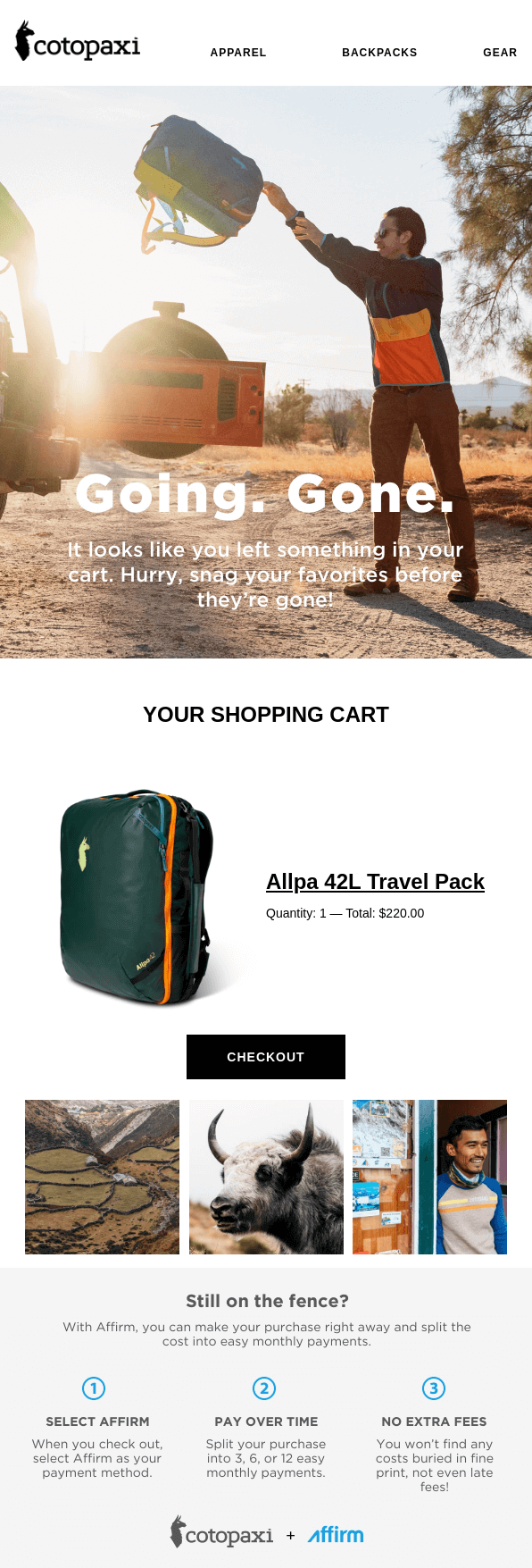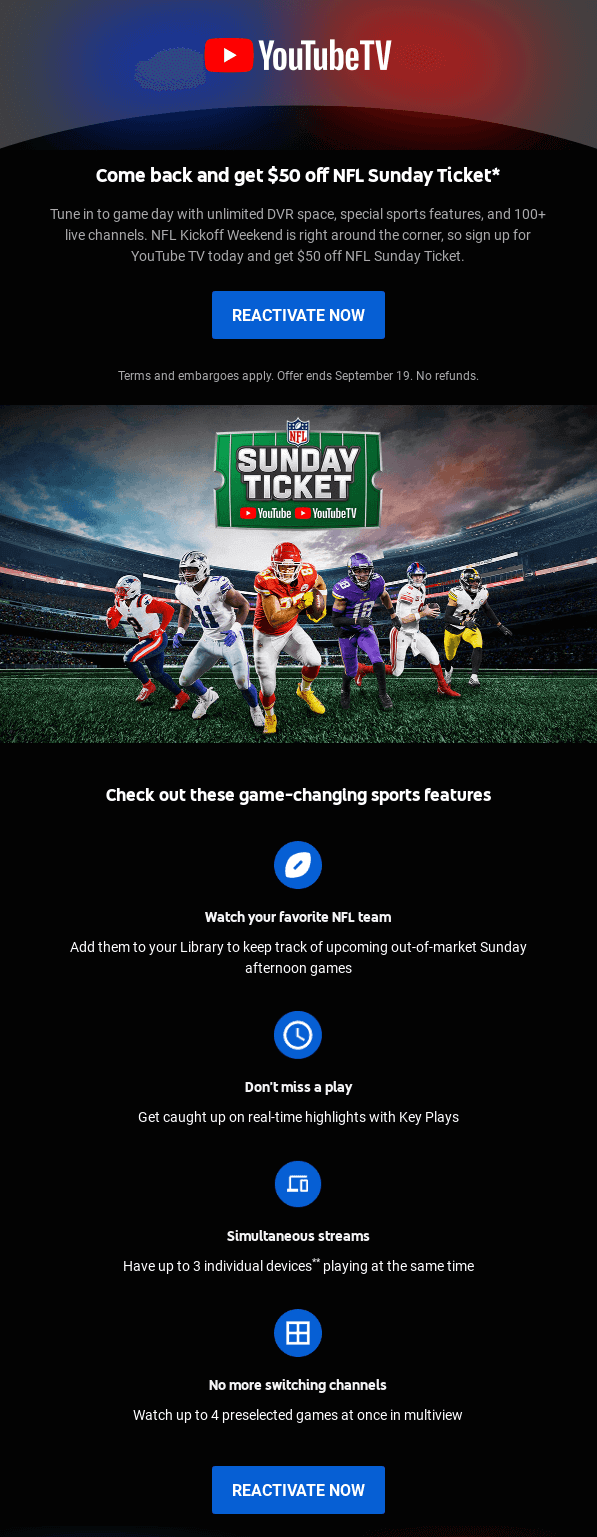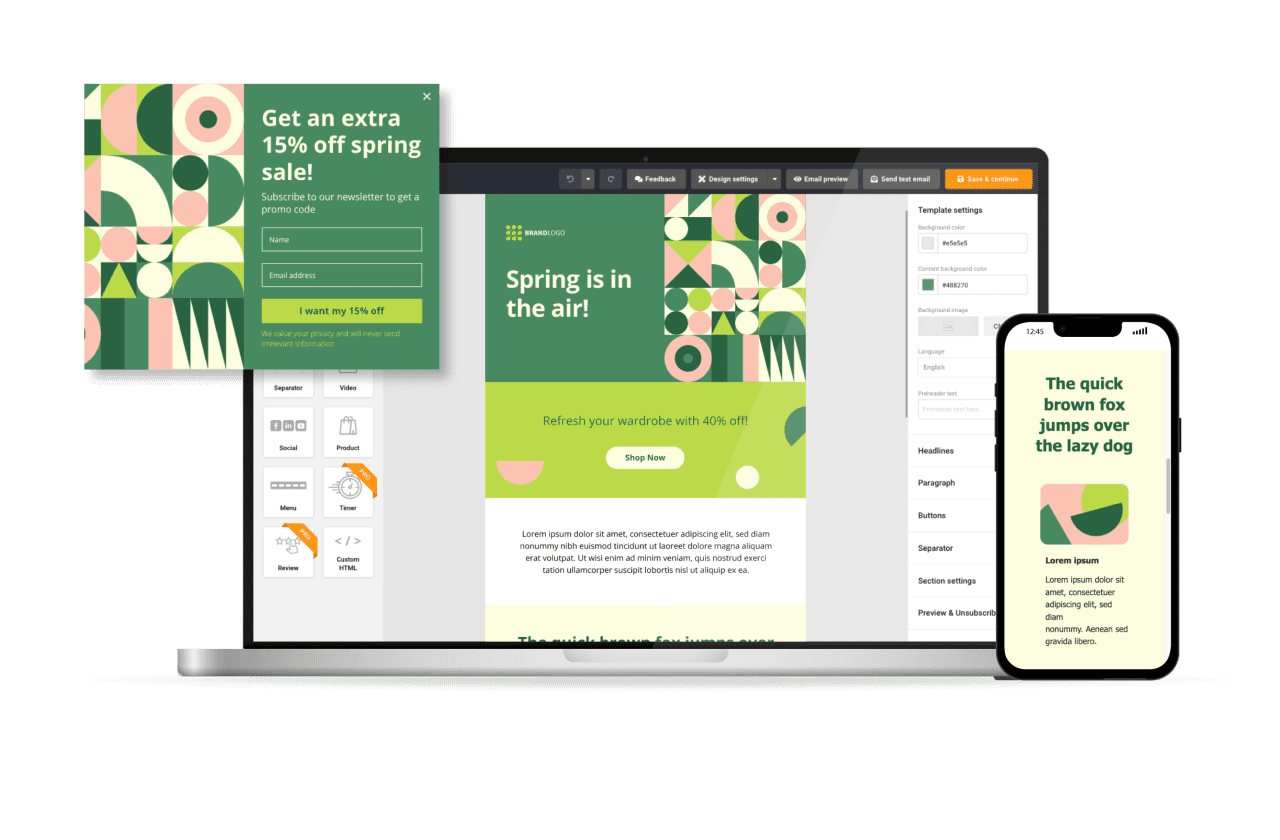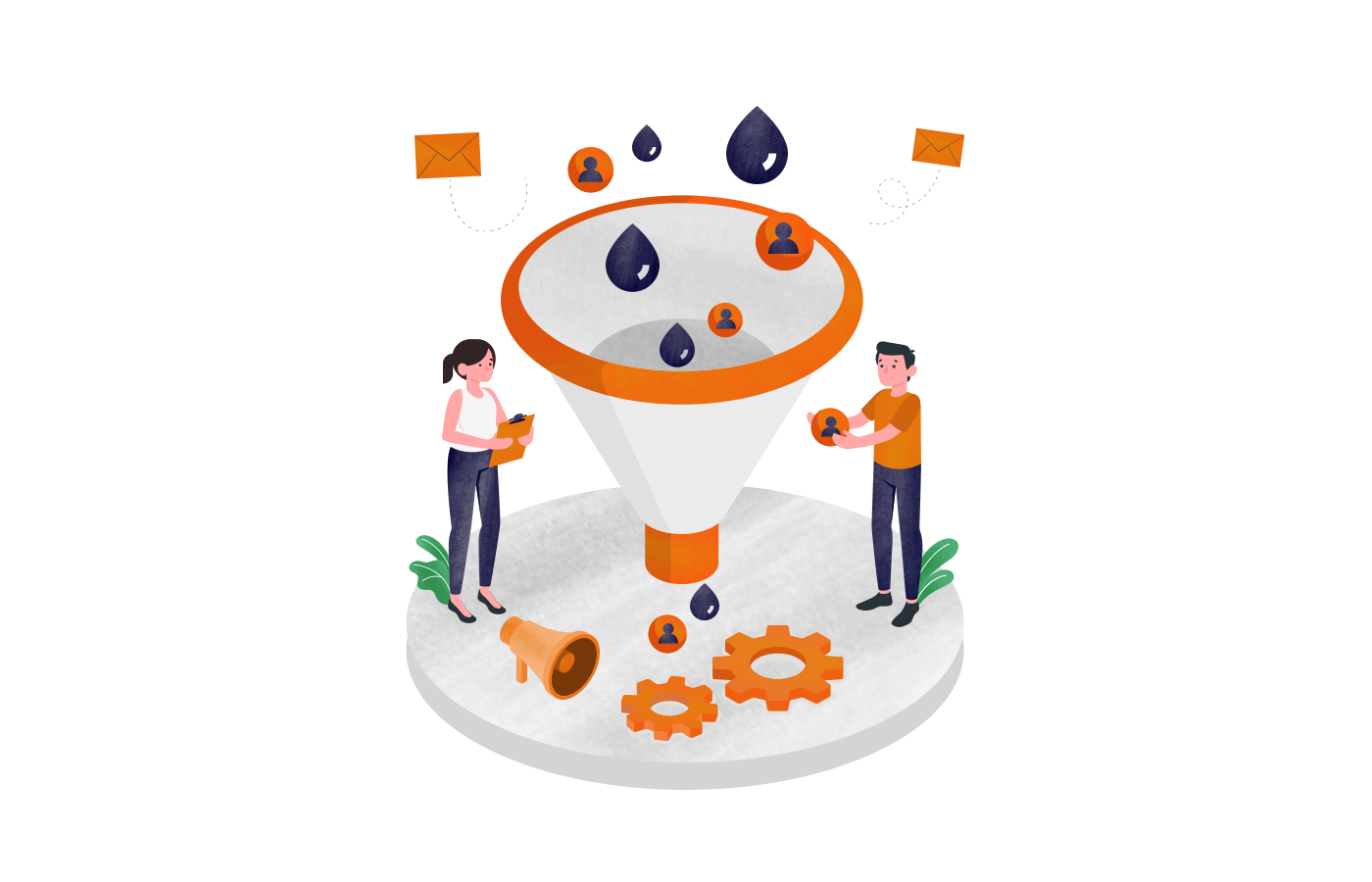If you’re a business owner who’s hands-on with marketing and likes to try different approaches, you’ve probably already googled ‘What is a drip email campaign?’.
Do drip campaigns work? And if they do, how do I measure drip campaign results for my business?
To answer the first question, let’s look at what industry statistics have to say. Compared to standalone email campaigns, drip campaigns have:
- 80% higher open rates approximately;
- 3x higher click-through rates, on average.
Don’t these numbers excite you?
This blog will guide you through everything you need to know about increasing sales revenue using a drip campaign strategy — from the meaning of drip marketing to real-world email drip campaign examples done right.
So, let’s get started!
What is Drip Marketing?
Drip email marketing involves sending automated emails to your subscribers in small parts. Instead of sending everything in one direct mail campaign, these campaigns are designed to share information as snippets, shared via multiple emails, over a period of time, with the goal of nurturing potential customers.
Drip campaigns slowly roll out content and marketing messages over time to engage new leads in an ongoing conversation. Think of them as a way to communicate with your customers regularly based on a specific timeline or user action.
Drip marketing is like setting up a sprinkler system that regularly waters the garden, ensuring every plant gets what it needs to flourish. It’s the perfect solution to engage with your leads and prospects as it involves:
- Personalization. Tailors content to meet individual user needs;
- Timeliness. Sends emails at optimal moments in the customer journey;
- Efficiency. Automates the process, saving time and resources;
- Engagement. Keeps users engaged with relevant, useful content;
- Conversion. Gently guides prospects through the buying journey.
Key Elements of a Drip Marketing Campaign
Automated drip campaigns sound fantastic, but most people making their first automation sequences often need help. So, let’s address the fundamental question — what should a drip campaign include?
Even the most successful drip campaigns have only three main components. Master your understanding of these, and you can design your winning automation sequence.
- Triggers. A trigger is an indicator that kickstarts your automation workflow and represents the first step of your automation design. Fundamentally, triggers are the actions that act as the basis of your drip campaign. The triggers include a time limit, a date, or a particular condition to be met.
- Conditions. The conditions include the type of trigger you want to apply. Some of the most common conditions include a user’s activity, location, and a user’s email activity or moving to a different email list. Conditions make your automation smart as it checks for a given situation and responds appropriately.
- Actions. Actions are what must happen when the specified conditions are met. You can move a subscriber to another email list, remove subscribers from a group, update a custom field, notify yourself (or your team), trigger an autoresponder, or do several actions based on triggers and conditions.
Building automation that works is simple with Sender when you nail down the above elements and have clarity on what needs to get done, i.e., the overall objective and what needs to happen at each step for that to happen.
Drip Marketing Examples
Now that you’ve got the basic idea about drip campaigns, let’s look at some real-life email drip sequence examples. Here are some interesting email marketing drip campaigns you can plan using a drip automation solution.
Welcome Series
Welcome email drip campaigns welcome a new user or subscriber and initiate a positive relationship with the prospect. It must be warm and thank the potential customer for signing up for the email list.
The welcome email should also deliver the promised ‘resource’ in case you mentioned it during the signup process or tell them more about your product or services.
Todd Snyder’s welcome email sequence perfectly conveys the genuine warmth of a hearty welcome. Have a look:

The email above is the first in a sequence of emails and sounds like a personal note as if written by a friend. The personal signature adds a personalized touch to the welcome message. If the message doesn’t melt a reader’s heart, the 15% off coupon definitely will.
Creating a drip campaign to welcome new customers like the one above is easy.
Drip sequence example
- Day 0 — Warm welcome. Immediately after someone signs up, send a personalized welcome email thanking them for joining your community or for their order. You can also offer a subscriber-only discount or a special gift to create a positive first impression. This email should be warm and inviting as it sets the tone and first impression for your brand;
- Day 1 — Introduce your brand. Share your brand’s story, values, and what makes you unique. You can also highlight testimonials or success stories to build credibility and trust. This email will help new users or subscribers feel connected and encourage them to stay engaged;
- Day 3 — Share something useful. Offer valuable resources or guidance related to your products or services, such as FAQs, how-tos, tips, etc. You can also just check-in and ask if everything suits their requirements. It’s a great way to add value while reassuring subscribers that they were right to engage with your brand.
Key Takeaways
- Write your welcome emails as a personalized note;
- Add a special offer, deal, or ‘value-add’ to your email to tempt potential customers to buy;
- Keep the email design simple and minimalistic.
Onboarding Series
For certain niches and types of businesses, such as software or online courses, the offer is a monthly recurring service or product that the user will initially need hand-holding.
An onboarding email drip campaign helps move new users through a maze, helping them make the most of their investment in a new product and showing them that you care about their experience. Look at the following onboarding email from Domestika:

Their onboarding email welcomes newly (and apparently “free”) signed-up users and provides them an option to directly shop the top courses while urging the user also to fill up their profile. Major course categories are also displayed below if the user simply wants to browse around.
Also, the main CTA urges the user to complete their profile, which is the next step in the user journey, as the more Domestika knows about them, the better it’ll help to personalize the recommendations.
Like Domestica, you can also set up an onboarding drip series.
Drip sequence example
- Day 0 — Share access. Send this email immediately after a purchase or sign-up. Include login details or a start guide, and reassure them of the value you’ll add. This email should make their next steps as easy as possible and provide any immediate resources they might need;
- Day 1 — Product/service deep dive. Share details about your product or service. Highlight key features and benefits, perhaps through an introductory video or a detailed guide. This email should improve their understanding, address apprehensions, and boost their excitement about what they’ve bought;
- Day 5 — Encourage first actions. Motivate users to take specific actions with your product or service. This can include setting up a profile, making a first transaction, or another meaningful step. Include a direct call to action to guide them;
- Day 7 — Request feedback. Check in to ask about their initial experience. Share a short survey or a simple reply-based question. Also, ask for feedback. Such an email would show them that you value their input and are there to help with any issues;
- Day 10 — Extend engagement. Offer additional resources or next steps to deepen their engagement. You might suggest advanced features of your product, upcoming events, or communities they can join to maximize their experience.
Key Takeaways
- Create the onboarding email as a how-to or tutorial consisting of the next steps;
- Add relevant suggestions about content to review, things to remember, or products to buy;
- Use a contextual CTA that appears like a natural ‘next step’ in the onboarding process.
Abandoned Cart Recovery Series
A customer comes to your website, browses everything, adds a few products to the cart, and leaves in between. How does that make you feel? Frustrated, right?
Abandoned cart recovery campaigns are sent to help you recover these abandoners and boost your revenue. Such a campaign can be automated as emails sent over time to remind customers they’re missing out on something important. Here’s an example email from an abandoned cart drip sequence by Cotopaxi.

The subject line “Don’t leave a good cart behind…” instantly reminds the reader that they forgot something. In fact, it induces FOMO and reminds them about their cart. Definitely a nice hook.
The header of this email is simple yet impactful. The image of throwing a bag in the trunk signifies their action. The copy induces FOMO, too. Using their cart and a checkout button is a nice add-on to this email.
That’s not it — the campaign offers an option to pay in installments. They could’ve added an extra discount to increase the impact of this email, though.
Drip sequence example
- Day 0 — 1 hour after abandonment. Send a gentle reminder about the items left in their cart, like the one above. You can highlight any extra offers and/or answer any apprehensions they might have. Include customer reviews or ratings to build trust;
- Day 0 — 5 hours after abandonment. Follow up with a limited-time discount or free shipping offer to encourage them to complete their purchase. Make the offer time-sensitive to create a sense of urgency. Don’t forget to use a compelling subject line;
- Day 2 — Last call. Alert them that the items in their cart are popular and the stock might run out soon. This email can convey a sense of scarcity and prompt immediate action to avoid missing out on a deal/exclusive product.
Key Takeaways
- Think of a powerful subject line that induces FOMO or urgency;
- Use contextual images, copy, or a relevant offer to convert cart abandoners;
- Address apprehensions and FAQs in your abandoned cart email sequence.
Re-Engagement Series
After a while, your subscribers might stop engaging with your brand because they have found something better, don’t have the time, or simply forget about you.
A re-engagement drip campaign is designed to engage these inactive subscribers again through a series of emails that might rope them back in. Sometimes, they also work as a part of lead nurturing campaigns. Here’s an example of a reactivation email by YouTube:

In this email, YouTube uses the classic tactic of dangling a lucrative ‘comeback’ offer in front of a user who used to pay for their service earlier. Plus, the reference to the sporting event shows they know the users—their love for the NFL.
The offer is clear in the first paragraph of the email, and the prominent CTA buttons are sure to attract clicks. The mention of the last date induces urgency in readers’ minds.
The email doesn’t end there. They’ve added information about contextual features for sports lovers (their target segment), which would encourage many subscribers to reactivate their accounts.
Drip sequence example
- Day 0 — “We Miss You” email. Start with a personalized email expressing that you’ve noticed their absence and miss them. Highlight any new features, collections, or changes they might have missed. This can be an emotion-inducing appeal to reconnect with your brand;
- Day 2 — Special offer for returning. Provide a special offer exclusive to them, such as a discount code or access to premium content, like the one above. This incentive can act as a catalyst to renew their interest and encourage them to engage with your brand again;
- Day 5 — Excite and induce FOMO. Send an update highlighting recent activities, top-selling products, or popular posts. You can also include user-generated content or testimonials to demonstrate ongoing community engagement and product satisfaction;
- Day 7 — Feedback request. Send an email asking for feedback on why they’ve been ignoring you or are disengaged. Include a simple survey or a direct way to respond. This shows you value their opinion and are willing to change based on their needs and suggestions.
Key Takeaways
- Know your audience and craft a contextual offer;
- Use straightforward copy that makes your offer or reason to re-engage clear from a glance;
- Add informational content that further convinces subscribers to re-engage.
Educational Series
Creating awareness and educating your audience about your product offerings is always a good idea. An informed audience is better equipped to decide in your favor, i.e., buy from you.
So, launching an educational series about your product features, benefits, or potential applications is a good idea for attracting customers and addressing their questions.
Here’s an example of an email from a drip education series about Hot Cold Relax from Sauna House:

The email is written as an informational blog covering all the aspects of the therapy/session. Using real images from the experience is a nice add-on to the entire email.
Following the general intro, there’s a blocked layout that helps a reader quickly glance over what the activity is all about. Bullet points and a contextual CTA at the end inspire a subscriber to explore more about the session.
Such an email is a good attempt to educate about a new add-on (in this case, an activity at the sauna center) and can bring lots of qualified inquiries or informed traffic your way.
Educating your audience is good for building long-term relationships.
Drip sequence example:
- Day 1 — Introduction to the topic. Start with an email that introduces the educational theme or series. Explain the benefits of mastering this topic and how it can improve their business or personal endeavors. Share what to expect from the next emails and set the stage for the detailed content that will follow;
- Day 2 — Give them an insight. Provide insightful information on a specific aspect of the service or product. This could include step-by-step guides, video tutorials, or case studies. Make the content actionable and relevant to the audience’s needs;
- Day 3 — Share practical examples. Showcase real-life examples or case studies demonstrating the practical application of the concepts discussed. This helps to cement their understanding and shows the real-world impact of what they’ve learned;
- Day 4 — Involve the reader. Encourage interaction by inviting them to a webinar Q&A session or providing a quiz to test their knowledge of the series topic. Interaction increases engagement and helps reinforce the learning material;
- Day 5 — Share recap and additional resources. Cover all the key points in the drip campaign series and provide additional resources for further learning. These might include books, articles, blogs, or courses that can provide deeper insights into the topic.
Key Takeaways
- Cover different aspects of a new product or feature in separate emails as a drip sequence;
- Write conversationally and add relevant pictures or tutorials to support your content;
- Remember that the CTA should be contextual and move the subscriber further into the buyer’s journey.
Should You Use Drip Marketing?
Drip marketing isn’t just about sending emails; it’s about establishing a dialogue with your audience. With drip campaigns, you’re effectively holding their hand through the journey from discovery to purchase.
Such an approach ensures that your message arrives not as a cold call in the dark but as a timely, welcomed conversation starter.
Also, drip marketing’s targeted approach means you’re not shouting into the void but rather whispering directly into the ears of those most likely to listen, engage, and respond.
But should you give drip advertising a thought? Here’s how drip campaigns will help your marketing efforts:
- Personalizes your approach. Imagine reading something that feels it’s written just for you. That’s what drip campaigns can do. When done right, they boost engagement and conversions;
- Boosts efficiency. Automation helps hit the sweet spot of timing and relevance. Plus, it’s more affordable to schedule automated drips to keep the conversations going without burning extra resources.
- Increases engagement. Regular and relevant emails create a bond with your audience, making them come back for more and transforming one-off buyers into a loyal squad;
- Data-driven optimization. Each interaction with a drip message sheds light on what your customers like, helping you fine-tune your offerings and strategy further;
- Promotes scalability. As you grow, so does drip marketing, keeping that personal touch without needing a bigger team or deeper pockets.
Tools like Sender’s drip workflow automation make it a breeze to start your drip campaign. And guess what? You can start for free.
So, why not turn those maybe-laters into right-nows and grow your community, one drip campaign at a time?

Author Bio
Anmol Ratan Sachdeva is a content marketer and small business consultant who has a strong grip on topics like marketing automation, email marketing, and content marketing. He loves to write about starting, improving, and growing a business.





